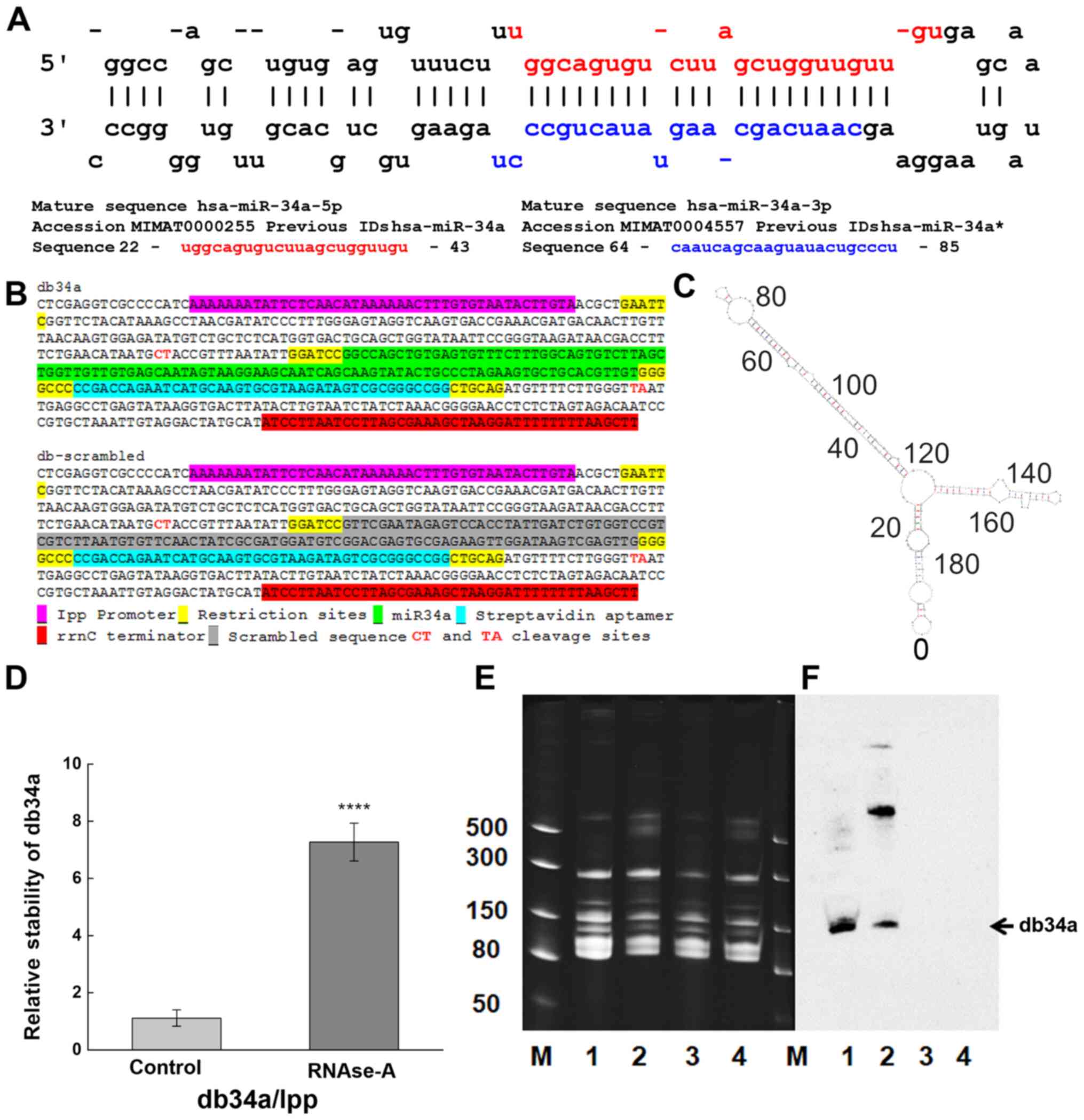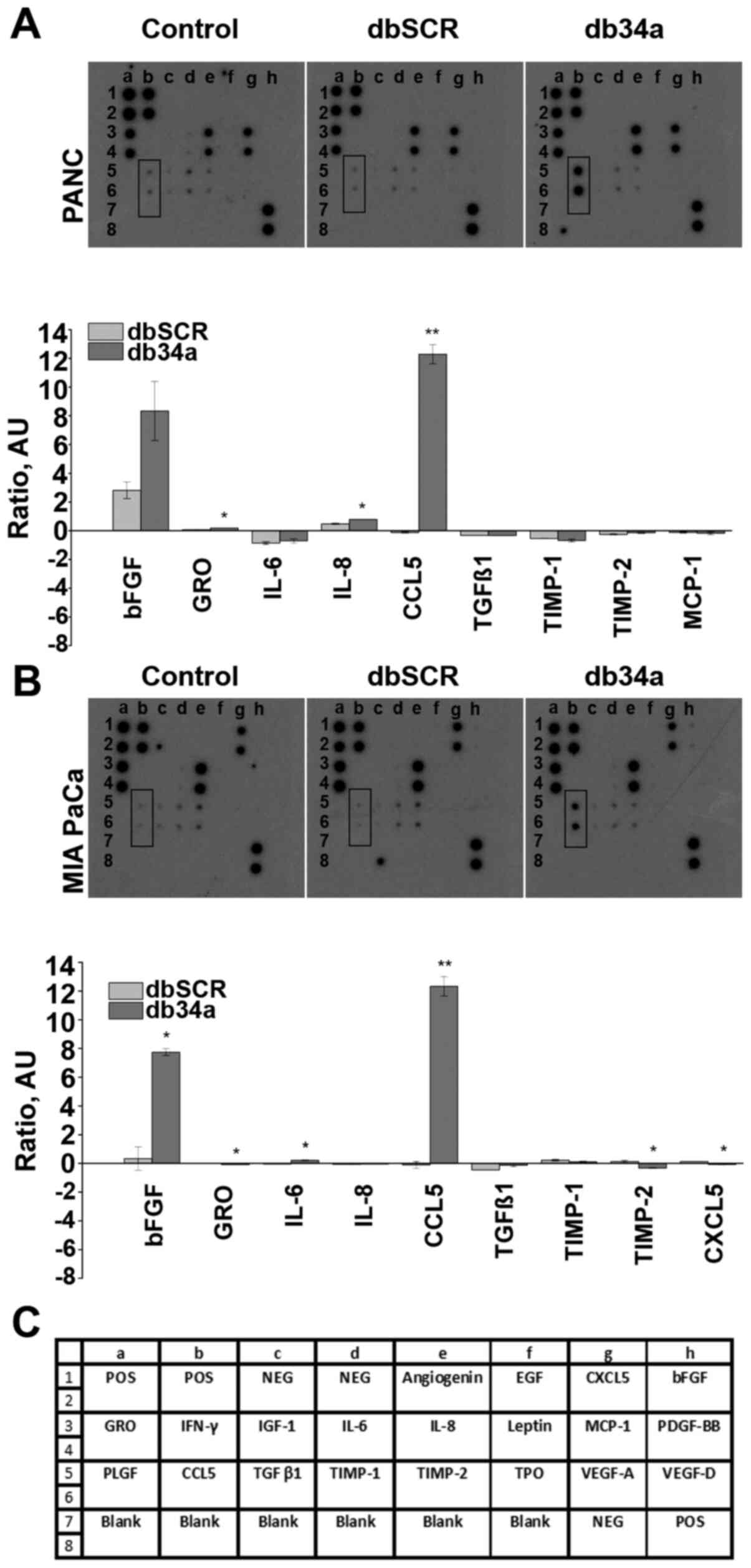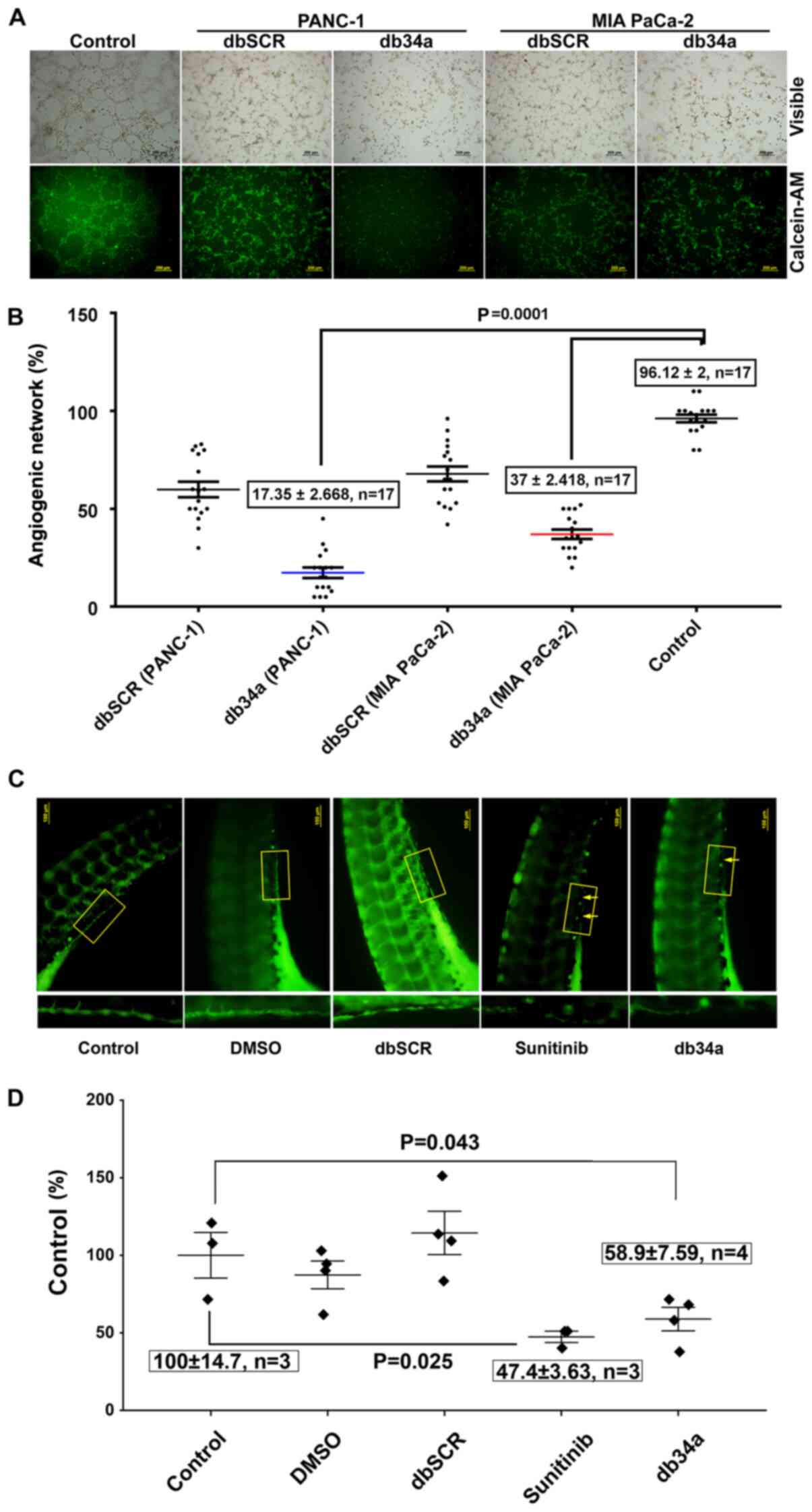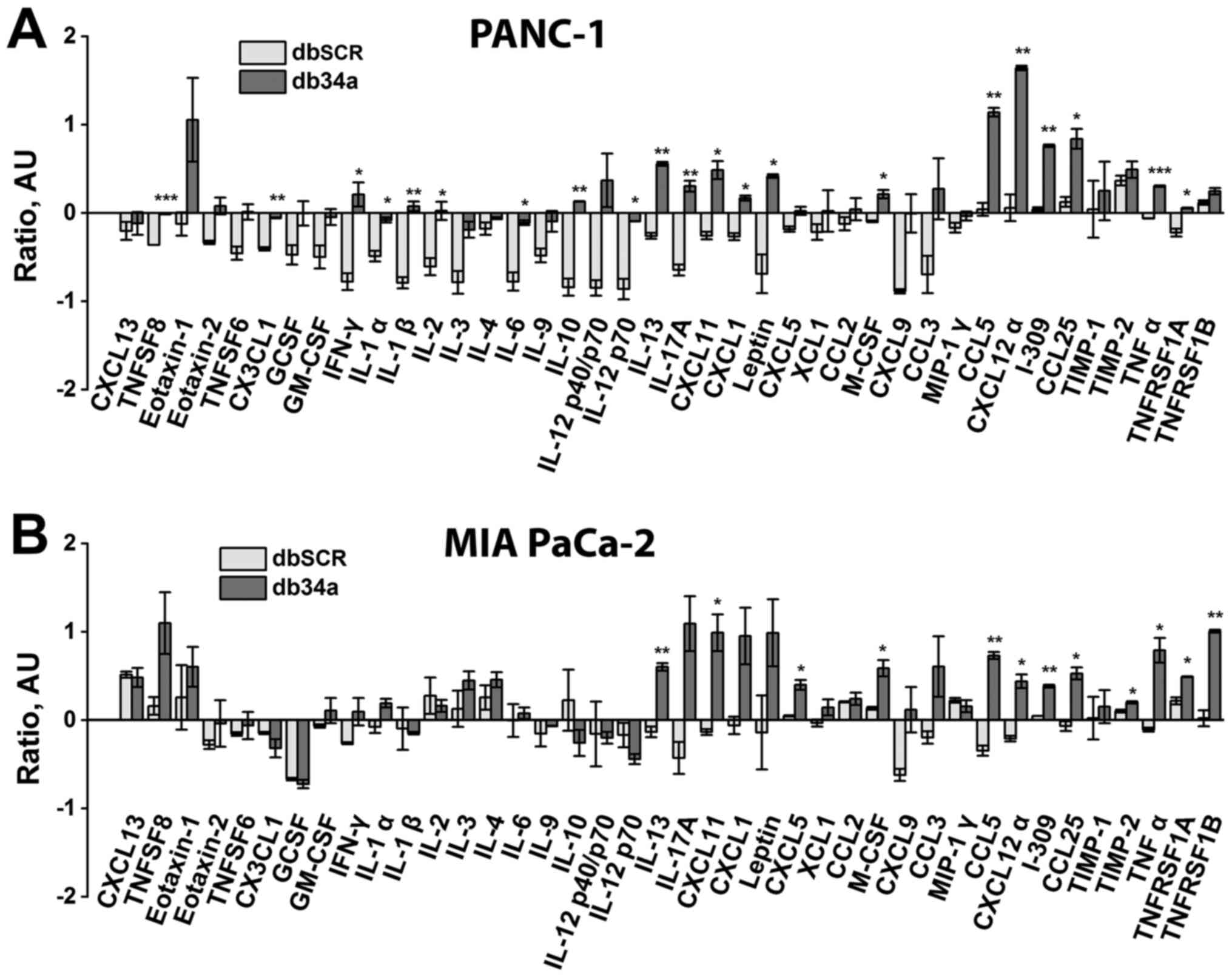|
1
|
Boehm T, Folkman J, Browder T and O'Reilly
MS: Antiangiogenic therapy of experimental cancer does not induce
acquired drug resistance. Nature. 390:404–407. 1997. View Article : Google Scholar : PubMed/NCBI
|
|
2
|
Zetter BR: Angiogenesis and tumor
metastasis. Annu Rev Med. 49:407–424. 1998. View Article : Google Scholar : PubMed/NCBI
|
|
3
|
Folkman J: Antiangiogenic gene therapy.
Proc Natl Acad Sci USA. 95:9064–9066. 1998. View Article : Google Scholar : PubMed/NCBI
|
|
4
|
Donmez G, Sullu Y, Baris S, Yildiz L,
Aydin O, Karagoz F and Kandemir B: Vascular endothelial growth
factor (VEGF), matrix metalloproteinase-9 (MMP-9), and
thrombospondin-1 (TSP-1) expression in urothelial carcinomas.
Pathol Res Pract. 205:854–7. 2009. View Article : Google Scholar : PubMed/NCBI
|
|
5
|
Neves KB, Montezano AC, Lang NN and Touyz
RM: Vascular toxicity associated with anti-angiogenic drugs. Clin
Sci (Lond). 134:2503–20. 2020. View Article : Google Scholar : PubMed/NCBI
|
|
6
|
Mattison R, Jumonville A, Flynn PJ,
Moreno-Aspitia A, Erlichman C, LaPlant B and Juckett MB: A phase II
study of AZD2171 (cediranib) in the treatment of patients with
acute myeloid leukemia or high-risk myelodysplastic syndrome. Leuk
Lymphoma. 56:2061–2066. 2015. View Article : Google Scholar : PubMed/NCBI
|
|
7
|
Hong DS, Garrido-Laguna I, Ekmekcioglu S,
Falchook GS, Naing A, Wheler JJ, Fu S, Moulder SL, Piha-Paul S,
Tsimberidou AM, et al: Dual inhibition of the vascular endothelial
growth factor pathway: A phase 1 trial evaluating bevacizumab and
AZD2171 (cediranib) in patients with advanced solid tumors. Cancer.
120:2164–2173. 2014. View Article : Google Scholar : PubMed/NCBI
|
|
8
|
Liu JF, Tolaney SM, Birrer M, Fleming GF,
Buss MK, Dahlberg SE, Lee H, Whalen C, Tyburski K, Winer E, et al:
A phase 1 trial of the poly(ADP-ribose) polymerase inhibitor
olaparib (AZD2281) in combination with the anti-angiogenic
cediranib (AZD2171) in recurrent epithelial ovarian or
triple-negative breast cancer. Eur J Cancer. 49:2972–2978. 2013.
View Article : Google Scholar : PubMed/NCBI
|
|
9
|
Climent-Salarich M, Quintavalle M,
Miragoli M, Chen J, Condorelli G and Elia L: TGFβ triggers
miR-143/145 transfer from smooth muscle cells to endothelial cells,
thereby modulating vessel stabilization. Circ Res. 116:1753–1764.
2015. View Article : Google Scholar : PubMed/NCBI
|
|
10
|
Huang G and Chen L: Tumor vasculature and
microenvironment normalization: A possible mechanism of
antiangiogenesis therapy. Cancer Biother Radiopharm. 23:661–667.
2008. View Article : Google Scholar : PubMed/NCBI
|
|
11
|
Barbas AS and White RR: The development
and testing of aptamers for cancer. Curr Opin Investig Drugs.
10:572–578. 2009.PubMed/NCBI
|
|
12
|
Guglielmelli T, Bringhen S and Palumbo A:
Update on the use of defibrotide. Expert Opin Biol Ther.
12:353–361. 2012. View Article : Google Scholar : PubMed/NCBI
|
|
13
|
Gatto B and Cavalli M: From proteins to
nucleic acid-based drugs: The role of biotech in anti-VEGF therapy.
Anticancer Agents Med Chem. 6:287–301. 2006. View Article : Google Scholar : PubMed/NCBI
|
|
14
|
Kanwar JR, Mahidhara G and Kanwar RK:
Antiangiogenic therapy using nanotechnological-based delivery
system. Drug Discov Today. 16:188–202. 2011. View Article : Google Scholar : PubMed/NCBI
|
|
15
|
Friedman AD, Kim D and Liu R: Highly
stable aptamers selected from a 20-fully modified fGmH RNA library
for targeting biomaterials. Biomaterials. 36:110–23. 2015.
View Article : Google Scholar : PubMed/NCBI
|
|
16
|
Inoue M, Kadonosono K, Arakawa A, Yamane S
and Ishibashi T: Long-term outcome of intravitreal pegaptanib
sodium as maintenance therapy in japanese patients with neovascular
age-related macular degeneration. Jpn J Ophthalmol. 59:173–178.
2015. View Article : Google Scholar : PubMed/NCBI
|
|
17
|
Puttaraju M and Been MD: Circular
ribozymes generated in Escherichia coli using group I
self-splicing permuted intron-exon sequences. J Biol Chem.
271:26081–26087. 1996. View Article : Google Scholar : PubMed/NCBI
|
|
18
|
Umekage S and Kikuchi Y: In vivo circular
RNA production using a constitutive promoter for high-level
expression. J Biosci Bioeng. 108:354–356. 2009. View Article : Google Scholar : PubMed/NCBI
|
|
19
|
Ford E and Ares M Jr: Synthesis of
circular RNA in bacteria and yeast using RNA cyclase ribozymes
derived from a group I intron of phage T4. Proc Natl Acad Sci USA.
91:3117–3121. 1994. View Article : Google Scholar : PubMed/NCBI
|
|
20
|
Ponchon L and Dardel F: Recombinant RNA
technology: The tRNA scaffold. Nat Methods. 4:571–576. 2007.
View Article : Google Scholar : PubMed/NCBI
|
|
21
|
Umekage S and Kikuchi Y: In vitro and in
vivo production and purification of circular RNA aptamer. J
Biotechnol. 139:265–272. 2009. View Article : Google Scholar : PubMed/NCBI
|
|
22
|
Zuker M: Mfold web server for nucleic acid
folding and hybridization prediction. Nucleic Acids Res.
31:3406–3415. 2003. View Article : Google Scholar : PubMed/NCBI
|
|
23
|
Nwokeoji AO, Kilby PM, Portwood DE and
Dickman MJ: RNASwift: A rapid, versatile RNA extraction method free
from phenol and chloroform. Anal Biochem. 512:36–46. 2016.
View Article : Google Scholar : PubMed/NCBI
|
|
24
|
Chen QX, Wang WP, Zeng S, Urayama S and Yu
AM: A general approach to high-yield biosynthesis of chimeric RNAs
bearing various types of functional small RNAs for broad
applications. Nucleic Acids Res. 43:3857–3869. 2015. View Article : Google Scholar : PubMed/NCBI
|
|
25
|
Livak KJ and Schmittgen TD: Analysis of
relative gene expression data using real-time quantitative PCR and
the 2(-delta delta C(T)) method. Methods. 25:402–408. 2001.
View Article : Google Scholar : PubMed/NCBI
|
|
26
|
Gnanamony M, Antony R, Fernandez KS, Jaime
L, Lin J, Joseph PA and Gondi CS: Chronic radiation exposure of
neuroblastoma cells reduces nMYC copy number. Oncol Lett.
14:3363–3370. 2017. View Article : Google Scholar : PubMed/NCBI
|
|
27
|
Kim S, Carlson R, Zafreen L, Rajpurohit SK
and Jagadeeswaran P: Modular, easy-to-assemble, low-cost zebrafish
facility. Zebrafish. 6:269–274. 2009. View Article : Google Scholar : PubMed/NCBI
|
|
28
|
Siegel RL, Miller KD and Jemal A: Cancer
statistics, 2019. CA Cancer J Clin. 69:7–34. 2019. View Article : Google Scholar : PubMed/NCBI
|
|
29
|
Jelski W and Mroczko B: Biochemical
diagnostics of pancreatic cancer-present and future. Clin Chim
Acta. 498:47–51. 2019. View Article : Google Scholar : PubMed/NCBI
|
|
30
|
McGuigan A, Kelly P, Turkington RC, Jones
C, Coleman HG and McCain RS: Pancreatic cancer: A review of
clinical diagnosis, epidemiology, treatment and outcomes. World J
Gastroenterol. 24:4846–4861. 2018. View Article : Google Scholar : PubMed/NCBI
|
|
31
|
Zhou LY, Qin Z, Zhu YH, He ZY and Xu T:
Current RNA-based therapeutics in clinical trials. Curr Gene Ther.
19:172–196. 2019. View Article : Google Scholar : PubMed/NCBI
|
|
32
|
Ambros V: microRNAs: Tiny regulators with
great potential. Cell. 107:823–826. 2001. View Article : Google Scholar : PubMed/NCBI
|
|
33
|
Toscano-Garibay JD and Aquino-Jarquin G:
Transcriptional regulation mechanism mediated by miRNA-DNA•DNA
triplex structure stabilized by Argonaute. Biochim Biophys Acta.
1839:1079–1083. 2014. View Article : Google Scholar : PubMed/NCBI
|
|
34
|
Li J, Mohammed-Elsabagh M, Paczkowski F
and Li Y: Circular nucleic acids: Discovery, functions and
applications. Chembiochem. 21:1547–1566. 2020. View Article : Google Scholar : PubMed/NCBI
|
|
35
|
Houseley J and Tollervey D: The many
pathways of RNA degradation. Cell. 136:763–776. 2009. View Article : Google Scholar : PubMed/NCBI
|
|
36
|
Ryther RC, Flynt AS, Phillips JA III and
Patton JG: siRNA therapeutics: Big potential from small RNAs. Gene
Ther. 12:5–11. 2005. View Article : Google Scholar : PubMed/NCBI
|
|
37
|
Bakhtiyari S, Haghani K, Basati G and
Karimfar MH: siRNA therapeutics in the treatment of diseases. Ther
Deliv. 4:45–57. 2013. View Article : Google Scholar : PubMed/NCBI
|
|
38
|
Park WS, Miyano-Kurosaki N, Abe T, Takai K
and Takaku H: Properties of circular dumbbell RNA/DNA chimeric
oligonucleotides containing antisense phosphodiester
oligonucleotides. Nucleic Acids Symp Ser. 225–226. 1999. View Article : Google Scholar : PubMed/NCBI
|
|
39
|
Yu H, Jiang X, Tan KT, Hang L and Patzel
V: Efficient production of superior dumbbell-shaped DNA minimal
vectors for small hairpin RNA expression. Nucleic Acids Res.
43:e1202015. View Article : Google Scholar : PubMed/NCBI
|
|
40
|
Jiang X, Yu H, Teo CR, Tan GS, Goh SC,
Patel P, Chua YK, Hameed NB, Bertoletti A and Patzel V: Advanced
design of dumbbell-shaped genetic minimal vectors improves
non-coding and coding RNA expression. Mol Ther. 24:1581–1591. 2016.
View Article : Google Scholar : PubMed/NCBI
|
|
41
|
Abe N, Abe H, Nagai C, Harada M,
Hatakeyama H, Harashima H, Ohshiro T, Nishihara M, Furukawa K,
Maeda M, et al: Synthesis, structure, and biological activity of
dumbbell-shaped nanocircular RNAs for RNA interference. Bioconjug
Chem. 22:2082–2092. 2011. View Article : Google Scholar : PubMed/NCBI
|
|
42
|
Misso G, Di Martino MT, De Rosa G, Farooqi
AA, Lombardi A, Campani V, Zarone MR, Gullà A, Tagliaferri P,
Tassone P and Caraglia M: Mir-34: A new weapon against cancer? Mol
Ther Nucleic Acids. 3:e1942014. View Article : Google Scholar : PubMed/NCBI
|
|
43
|
Li XJ, Ren ZJ and Tang JH: MicroRNA-34a: A
potential therapeutic target in human cancer. Cell Death Dis.
5:e13272014. View Article : Google Scholar : PubMed/NCBI
|
|
44
|
Kofman AV, Kim J, Park SY, Dupart E,
Letson C, Bao Y, Ding K, Chen Q, Schiff D, Larner J and Abounader
R: microRNA-34a promotes DNA damage and mitotic catastrophe. Cell
Cycle. 12:3500–3511. 2013. View Article : Google Scholar : PubMed/NCBI
|
|
45
|
Kumar B, Yadav A, Lang J, Teknos TN and
Kumar P: Dysregulation of microRNA-34a expression in head and neck
squamous cell carcinoma promotes tumor growth and tumor
angiogenesis. PLoS One. 7:e376012012. View Article : Google Scholar : PubMed/NCBI
|
|
46
|
Tivnan A, Tracey L, Buckley PG, Alcock LC,
Davidoff AM and Stallings RL: MicroRNA-34a is a potent tumor
suppressor molecule in vivo in neuroblastoma. BMC Cancer.
11:332011. View Article : Google Scholar : PubMed/NCBI
|
|
47
|
Gallardo E, Navarro A, Vinolas N, Marrades
RM, Diaz T, Gel B, Quera A, Bandres E, Garcia-Foncillas J, Ramirez
J and Monzo M: miR-34a as a prognostic marker of relapse in
surgically resected non-small-cell lung cancer. Carcinogenesis.
30:1903–1909. 2009. View Article : Google Scholar : PubMed/NCBI
|
|
48
|
Wei JS, Song YK, Durinck S, Chen QR, Cheuk
AT, Tsang P, Zhang Q, Thiele CJ, Slack A, Shohet J and Khan J: The
MYCN oncogene is a direct target of miR-34a. Oncogene.
27:5204–5213. 2008. View Article : Google Scholar : PubMed/NCBI
|
|
49
|
Bommer GT, Gerin I, Feng Y, Kaczorowski
AJ, Kuick R, Love RE, Zhai Y, Giordano TJ, Qin ZS, Moore BB, et al:
p53-mediated activation of miRNA34 candidate tumor-suppressor
genes. Curr Biol. 17:1298–1307. 2007. View Article : Google Scholar : PubMed/NCBI
|
|
50
|
Bozgeyik E, Tepe NB and Bozdag Z:
Identification of microRNA expression signature for the diagnosis
and prognosis of cervical squamous cell carcinoma. Pathol Res
Pract. 216:1531592020. View Article : Google Scholar : PubMed/NCBI
|
|
51
|
Barnes PJ, Baker J and Donnelly LE:
Cellular senescence as a mechanism and target in chronic lung
diseases. Am J Respir Crit Care Med. 200:556–564. 2019. View Article : Google Scholar : PubMed/NCBI
|
|
52
|
Zhai L, Zhao Y, Liu Z, Wu J and Lin L:
mRNA expression profile analysis reveals a C-MYC/miR-34a pathway
involved in the apoptosis of diffuse large B-cell lymphoma cells
induced by yiqichutan treatment. Exp Ther Med. 20:2157–2165.
2020.PubMed/NCBI
|
|
53
|
Jiang C, Cheng Z, Jiang T, Xu Y and Wang
B: MicroRNA-34a inhibits cell invasion and epithelial-mesenchymal
transition via targeting AXL/PI3K/AKT/snail signaling in
nasopharyngeal carcinoma. Genes Genomics. 42:971–978. 2020.
View Article : Google Scholar : PubMed/NCBI
|
|
54
|
Wang S, Tang Q, Ge F and Guo Q: Typhae
pollen polysaccharides protect hypoxia-induced PC12 cell injury via
regulation of miR-34a/SIRT1. Int J Immunopathol Pharmacol.
34:20587384209100052020. View Article : Google Scholar : PubMed/NCBI
|
|
55
|
Zhang YM, Wu QM, Chang LY and Liu JC:
miR-34a and miR-125a-5p inhibit proliferation and metastasis but
induce apoptosis in hepatocellular carcinoma cells via repressing
the MACC1-mediated PI3K/AKT/mTOR pathway. Neoplasma. 67:1042–1053.
2020. View Article : Google Scholar : PubMed/NCBI
|
|
56
|
Tao H, Cheng L and Yang R: Downregulation
of miR-34a promotes proliferation and inhibits apoptosis of rat
osteoarthritic cartilage cells by activating PI3K/akt pathway. Clin
Interv Aging. 15:373–385. 2020. View Article : Google Scholar : PubMed/NCBI
|
|
57
|
Mahdavi Sharif P, Jabbari P, Razi S,
Keshavarz-Fathi M and Rezaei N: Importance of TNF-alpha and its
alterations in the development of cancers. Cytokine.
130:1550662020. View Article : Google Scholar : PubMed/NCBI
|
|
58
|
Scarlatti G, Tresoldi E, Bjorndal A,
Fredriksson R, Colognesi C, Deng HK, Malnati MS, Plebani A,
Siccardi AG, Littman DR, et al: In vivo evolution of HIV-1
co-receptor usage and sensitivity to chemokine-mediated
suppression. Nat Med. 3:1259–1265. 1997. View Article : Google Scholar : PubMed/NCBI
|
|
59
|
Cocchi F, DeVico AL, Garzino-Demo A, Arya
SK, Gallo RC and Lusso P: Identification of RANTES, MIP-1 alpha,
and MIP-1 beta as the major HIV-suppressive factors produced by
CD8+ T cells. Science. 270:1811–5. 1995. View Article : Google Scholar : PubMed/NCBI
|
|
60
|
Singh SK, Mishra MK, Eltoum IA, Bae S,
Lillard JW Jr and Singh R: CCR5/CCL5 axis interaction promotes
migratory and invasiveness of pancreatic cancer cells. Sci Rep.
8:13232018. View Article : Google Scholar : PubMed/NCBI
|
|
61
|
Voshtani R, Song M, Wang H, Li X, Zhang W,
Tavallaie MS, Yan W, Sun J, Wei F and Ma X: Progranulin promotes
melanoma progression by inhibiting natural killer cell recruitment
to the tumor microenvironment. Cancer Lett. 465:24–35. 2019.
View Article : Google Scholar : PubMed/NCBI
|
|
62
|
Li L, Yang L, Cheng S, Fan Z, Shen Z, Xue
W, Zheng Y, Li F, Wang D, Zhang K, et al: Lung
adenocarcinoma-intrinsic GBE1 signaling inhibits anti-tumor
immunity. Mol Cancer. 18:1082019. View Article : Google Scholar : PubMed/NCBI
|
|
63
|
Ruiz de Galarreta M, Bresnahan E,
Molina-Sanchez P, Lindblad KE, Maier B, Sia D, Puigvehi M, Miguela
V, Casanova-Acebes M, Dhainaut M, et al: β-catenin activation
promotes immune escape and resistance to anti-PD-1 therapy in
hepatocellular carcinoma. Cancer Discov. 9:1124–1141. 2019.
View Article : Google Scholar : PubMed/NCBI
|
|
64
|
Wang J, Wang Y, Kong F, Han R, Song W,
Chen D, Bu L, Wang S, Yue J and Ma L: Identification of a six-gene
prognostic signature for oral squamous cell carcinoma. J Cell
Physiol. 235:3056–3068. 2020. View Article : Google Scholar : PubMed/NCBI
|
|
65
|
An G, Wu F, Huang S, Feng L, Bai J, Gu S
and Zhao X: Effects of CCL5 on the biological behavior of breast
cancer and the mechanisms of its interaction with tumorassociated
macrophages. Oncol Rep. 42:2499–2511. 2019.PubMed/NCBI
|
|
66
|
Komohara Y, Fujiwara Y, Ohnishi K and
Takeya M: Tumor-associated macrophages: Potential therapeutic
targets for anti-cancer therapy. Adv Drug Deliv Rev. 99:180–185.
2016. View Article : Google Scholar : PubMed/NCBI
|
|
67
|
Cui R, Yue W, Lattime EC, Stein MN, Xu Q
and Tan XL: Targeting tumor-associated macrophages to combat
pancreatic cancer. Oncotarget. 7:50735–50754. 2016. View Article : Google Scholar : PubMed/NCBI
|
|
68
|
Bosurgi L, Cao YG, Cabeza-Cabrerizo M,
Tucci A, Hughes LD, Kong Y, Weinstein JS, Licona-Limon P, Schmid
ET, Pelorosso F, et al: Macrophage function in tissue repair and
remodeling requires IL-4 or IL-13 with apoptotic cells. Science.
356:1072–1076. 2017. View Article : Google Scholar : PubMed/NCBI
|


















